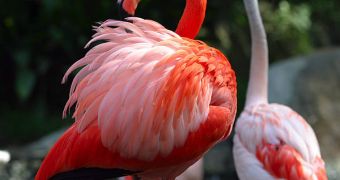One of the main questions people ask themselves or others around them whenever they see a flamingo is why exactly this bird stands on only one foot, when it has two perfectly good ones. Despite efforts made to understand this behavior, biologists have thus far came up short. Now, a new scientific study seems to have found the explanation for this fact – the birds may be thermo-regulating while doing this. Comparative psychologists Matthew Anderson and Sarah Williams, both from the Saint Joseph's University in Philadelphia, made the find, after an exhaustive study of captive Caribbean flamingos, the BBC News informs.
“Flamingos captured my attention for a variety of reasons. Scientifically speaking, their highly gregarious nature makes them an ideal species for investigating social influences on behavior. Aesthetically speaking, they are large, beautiful, and iconic. Perhaps most importantly, I was very surprised to discover how little systematic, hypothesis-driven empirical research had been conducted on flamingos,” says Anderson of his interest in the beautiful birds.
During the investigation, the researchers found no preference in flamingos for either of their feet. Rather, they rest on whichever they feel like at the moment. When it comes to resting their heads, however, that story changes completely. The study revealed the fact that most flamingos tend to be resting their head on the right side of the body. Those who place it on the left are more likely to engage in aggressive behavior within the group. This find seems to support a scientific theory which holds that right-handedness promotes social cohesion within a group, be it birds, mammals or humans.
According to the new theory Anderson and Williams devised, it would appear that flamingos stand on one leg while in the water to conserve body heat. It would stand to reason, they say, that the cold water draws heat from their bodies, and so having both feet in the water would accelerate this process. By standing on a single one, the birds minimize the amount of heat lost. “As water invariably draws away more body heat, this result supports the thermo-regulation hypothesis,” Anderson states.
“The results provide definitive evidence that thermo-regulation is a principal function of unipedal resting in flamingos,” he adds. The study also revealed that the birds like to change the foot they relay on from time to time, so as to avoid damage to it. “If they stood on one leg consistently, they would risk greater loss of body heat and potential tissue damage in the cold,” the expert explains.

 14 DAY TRIAL //
14 DAY TRIAL //